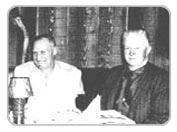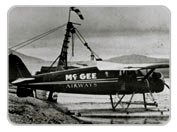Mac McGee
At Alaska Airlines, our roots trace back to the Great Depression and the resourcefulness of Mac McGee. For Linious "Mac" McGee, 1932 marked the beginning of a new way of life, and steady work.
Seeking opportunity during the Great Depression, he stowed away on an Alaska-bound steamship hoping to find better times. The Indiana native and transplanted Montanan went on to worked as a miner, truck driver, dishwasher, and fur buyer in turn. But it wasn't until 1932 that he found his calling when he launched an airline that would, after years of aviation pioneering, grow to become one of the largest airlines based in the US.
Along the way, he teamed with other aviation adventurers, such as Harvey Barnhill, Charlie Ruttan, Steve Mills, and Oscar Winchell, to help revolutionize transportation in the Alaska Territory. By overcoming tremendous risks—frequent crashes, forced landings, terrible weather, unreliable airplanes, primitive navigation, and Alaska's vast and unforgiving terrain—Mac and his colleagues became vital parts of the state's history.
Getting started
McGee and Barnhill, a barnstormer of some renown, partnered up in 1931 to buy a three-seat Stinson for $5,000 from a San Francisco outfit that was the parent company of United Airlines. The plane initially was used to support McGee's fur-buying business.

But in January 1932, McGee and Barnhill started advertising their company in the Anchorage Daily Times as a furrier, but also as an airline offering service between Anchorage and Bristol Bay. Barnhill and McGee dissolved their partnership in the late spring of 1932, shortly after using a bank loan to buy a second Stinson. Barnhill kept the newer plane, but sold it back to McGee at the onset of winter.
McGee then hired Winchell, a highly regarded bush pilot. He made Winchell a unique offer—his pay would be 12 1/2 percent of the gross business he was able to generate with McGee's plane, making him a commissioned salesman. This scheme helped keep McGee's planes full wherever they flew.
McGee was a workaholic known to run or jog everywhere. He worked seven days a week and asked his employees for the same dedication, but never drove them beyond the bounds of reason. He was said to be as honest as summer days are long in Alaska.

McGee pioneered the concept of having a fleet of identical aircraft so that parts would be interchangeable. Despite his hard work and innovation, McGee was on the brink of financial disaster for several years. He sometimes could not make his payroll and his pilots often had more in the bank than he did.
As McGee was struggling to survive, competition was increasing. In April 1932, Star Air Service was formed when Alaskan mining engineer Wesley "Earl" Dunkle loaned money to pilots Steve Mills, Charlie Ruttan, and Jack Waterworth, to offer flight classes and charter services with their Fleet biplane.
Joining forces
McGee, itching to work some mining claims he had staked, agreed to sell McGee Airways and his seven silver-and-black Stinsons to Star Air Service for $50,000, creating the largest airline in Alaska with 22 aircraft. However, he sold with one condition: if McGee didn't get paid on time, he would return to manage the airline until he got all of his money.
Sure enough, McGee was soon back running the business. He paid himself three percent of the airline's gross. And by 1936, Star's gross income was $190,000 a year. Passengers were charged 20 cents a mile, and 35 percent of all freight moved in the territory was by plane.
Aviation opened up The Great Land, but it was not without cost. A number of pilots were killed, including Steve Mills in a 1936 crash. Others got lost in storms, never to be seen again. Engines froze in flight, rings and push rods broke, and valves burned out, tails and wings fell off, landing gear snapped, wooden parts rotted, fabric skins were torn, and fierce storms sometimes blew planes away. It was an environment unforgiving of men and their machines.
After Mills was killed, McGee bought out Waterworth's share of Star Air Service and ran operations until his mining interests again prevailed. When Kenny Neese, McGee's successor as manager, left the airline McGee again returned yet again to manage the company. He expanded business by buying struggling Alaska Interior Airlines, a carrier founded by McGee Airways' first pilot, Oscar Winchell.
Ruttan left Star in the late 1930s when he purchased an oil distributorship. Then, in late 1937, increasingly frustrated by the growing presence of federal regulators in Alaska skies, McGee sold the airline to a corporation of investors led by one of his former pilots, Don Goodman, and the Strandbergs, a successful Kuskokwim mining family. They changed the name of the carrier from Star Air Service to Star Air Lines. When Goodman and the Strandbergs sold the airline in 1942, the name was changed to Alaska Star Airlines and in 1944 the name was changed for the last time—to Alaska Airlines.
Mac, meanwhile, never returned to the airline business, instead opening a very successful liquor store and eventually returning to placer mining in the Manley Hot Springs area. He retired at age 73 and moved to Vancouver, Washington, before settling in Reno, Nevada, where he died at age 91 in June 1988.